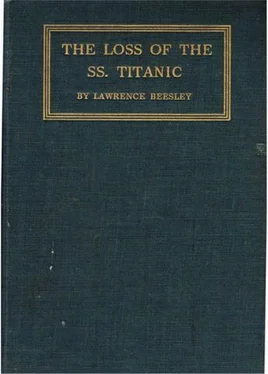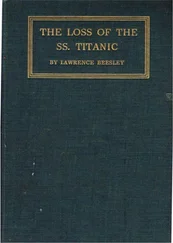Bulkheads and water-tight compartments
It is impossible to attempt a discussion here of the exact constructional details of these parts of a ship; but in order to illustrate briefly what is the purpose of having bulkheads, we may take the Titanic as an example. She was divided into sixteen compartments by fifteen transverse steel walls called bulkheads. [4] See Figures 1 and 2 page 116.
If a hole is made in the side of the ship in any one compartment, steel water-tight doors seal off the only openings in that compartment and separate it as a damaged unit from the rest of the ship and the vessel is brought to land in safety. Ships have even put into the nearest port for inspection after collision, and finding only one compartment full of water and no other damage, have left again, for their home port without troubling to disembark passengers and effect repairs.
The design of the Titanic’s bulkheads calls for some attention. The “Scientific American,” in an excellent article on the comparative safety of the Titanic’s and other types of water-tight compartments, draws attention to the following weaknesses in the former—from the point of view of possible collision with an iceberg. She had no longitudinal bulkheads, which would subdivide her into smaller compartments and prevent the water filling the whole of a large compartment. Probably, too, the length of a large compartment was in any case too great—fifty-three feet.
The Mauretania, on the other hand, in addition to transverse bulkheads, is fitted with longitudinal torpedo bulkheads, and the space between them and the side of the ship is utilised as a coal bunker. Then, too, in the Mauretania all bulkheads are carried up to the top deck, whereas in the case of the Titanic they reached in some parts only to the saloon deck and in others to a lower deck still,—the weakness of this being that, when the water reached to the top of a bulkhead as the ship sank by the head, it flowed over and filled the next compartment. The British Admiralty, which subsidizes the Mauretania and Lusitania as fast cruisers in time of war, insisted on this type of construction, and it is considered vastly better than that used in the Titanic. The writer of the article thinks it possible that these ships might not have sunk as the result of a similar collision. But the ideal ship from the point of bulkhead construction, he considers to have been the Great Eastern, constructed many years ago by the famous engineer Brunel. So thorough was her system of compartments divided and subdivided by many transverse and longitudinal bulkheads that when she tore a hole eighty feet long in her side by striking a rock, she reached port in safety. Unfortunately the weight and cost of this method was so great that his plan was subsequently abandoned.
But it would not be just to say that the construction of the Titanic was a serious mistake on the part of the White Star Line or her builders, on the ground that her bulkheads were not so well constructed as those of the Lusitania and Mauretania, which were built to fulfil British Admiralty regulations for time of war—an extraordinary risk which no builder of a passenger steamer—as such—would be expected to take into consideration when designing the vessel. It should be constantly borne in mind that the Titanic met extraordinary conditions on the night of the collision: she was probably the safest ship afloat in all ordinary conditions. Collision with an iceberg is not an ordinary risk; but this disaster will probably result in altering the whole construction of bulkheads and compartments to the Great Eastern type, in order to include the one-in-a-million risk of iceberg collision and loss.
Here comes in the question of increased cost of construction, and in addition the great loss of cargo-carrying space with decreased earning capacity, both of which will mean an increase in the passenger rates. This the travelling public will have to face and undoubtedly will be willing to face for the satisfaction of knowing that what was so confidently affirmed by passengers on the Titanic’s deck that night of the collision will then be really true,—that “we are on an unsinkable boat,”—so far as human forethought can devise. After all, this must be the solution to the problem how best to ensure safety at sea. Other safety appliances are useful and necessary, but not useable in certain conditions of weather. The ship itself must always be the “safety appliance” that is really trustworthy, and nothing must be left undone to ensure this.
Wireless apparatus and operators
The range of the apparatus might well be extended, but the principal defect is the lack of an operator for night duty on some ships. The awful fact that the Californian lay a few miles away, able to save every soul on board, and could not catch the message because the operator was asleep, seems too cruel to dwell upon. Even on the Carpathia, the operator was on the point of retiring when the message arrived, and we should have been much longer afloat—and some boats possibly swamped—had he not caught the message when he did. It has been suggested that officers should have a working knowledge of wireless telegraphy, and this is no doubt a wise provision. It would enable them to supervise the work of the operators more closely and from all the evidence, this seems a necessity. The exchange of vitally important messages between a sinking ship and those rushing to her rescue should be under the control of an experienced officer. To take but one example—Bride testified that after giving the Birma the “C.Q.D.” message and the position (incidentally Signer Marconi has stated that this has been abandoned in favour of “S.O.S.”) and getting a reply, they got into touch with the Carpathia, and while talking with her were interrupted by the Birma asking what was the matter. No doubt it was the duty of the Birma to come at once without asking any questions, but the reply from the Titanic, telling the Birma’s operator not to be a “fool” by interrupting, seems to have been a needless waste of precious moments: to reply, “We are sinking” would have taken no longer, especially when in their own estimation of the strength of the signals they thought the Birma was the nearer ship. It is well to notice that some large liners have already a staff of three operators.
Submarine signalling apparatus
There are occasions when wireless apparatus is useless as a means of saving life at sea promptly.
One of its weaknesses is that when the ships’ engines are stopped, messages can no longer be sent out, that is, with the system at present adopted. It will be remembered that the Titanic’s messages got gradually fainter and then ceased altogether as she came to rest with her engines shut down.
Again, in fogs,—and most accidents occur in fogs,—while wireless informs of the accident, it does not enable one ship to locate another closely enough to take off her passengers at once. There is as yet no method known by which wireless telegraphy will fix the direction of a message; and after a ship has been in fog for any considerable length of time it is more difficult to give the exact position to another vessel bringing help.
Nothing could illustrate these two points better than the story of how the Baltic found the Republic in the year 1909, in a dense fog off Nantucket Lightship, when the latter was drifting helplessly after collision with the Florida. The Baltic received a wireless message stating the Republic’s condition and the information that she was in touch with Nantucket through a submarine bell which she could hear ringing. The Baltic turned and went towards the position in the fog, picked up the submarine bell-signal from Nantucket, and then began searching near this position for the Republic. It took her twelve hours to find the damaged ship, zigzagging across a circle within which she thought the Republic might lie. In a rough sea it is doubtful whether the Republic would have remained afloat long enough for the Baltic to find her and take off all her passengers.
Читать дальше












